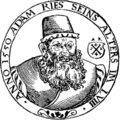Template:Selected anniversaries/March 30: Difference between revisions
No edit summary |
No edit summary |
||
| Line 1: | Line 1: | ||
<gallery> | <gallery> | ||
||1202: Joachim of Fiore dies ... mystic and theologian. No DOB. Pic. | ||1202: Joachim of Fiore dies ... mystic and theologian. No DOB. Pic. | ||
| Line 10: | Line 9: | ||
||1689: Kazimierz Łyszczyński dies ... Polish-Lithuanian nobleman, landowner in Brest Litovsk Voivodeship of the Grand Duchy of Lithuania, philosopher, and soldier in the ranks of the Sapieha family, who was accused, tried, and executed for atheism in 1689. Pic: postage stamp. | ||1689: Kazimierz Łyszczyński dies ... Polish-Lithuanian nobleman, landowner in Brest Litovsk Voivodeship of the Grand Duchy of Lithuania, philosopher, and soldier in the ranks of the Sapieha family, who was accused, tried, and executed for atheism in 1689. Pic: postage stamp. | ||
||1707: Sébastien Le Prestre de Vauban dies ... | ||1707: French general and military engineer Sébastien Le Prestre de Vauban dies. He participated in each of the wars fought by France during the reign of Louis XIV. His design principles served as the dominant model of fortification for nearly 100 years, while his offensive tactics remained in use until the early twentieth century. Pic. | ||
||1754: Jean-François Pilâtre de Rozier born ... chemistry and physics teacher, and one of the first pioneers of aviation. He and the Marquis d'Arlandes made the first manned free balloon flight on 21 November 1783, in a Montgolfier balloon. Pic. | ||1754: Jean-François Pilâtre de Rozier born ... chemistry and physics teacher, and one of the first pioneers of aviation. He and the Marquis d'Arlandes made the first manned free balloon flight on 21 November 1783, in a Montgolfier balloon. Pic. | ||
Revision as of 20:07, 29 March 2019
1599: Mathematician Adam Ries dies. He wrote textbooks for practical mathematics, promoting the advantages of Arabic/Indian numerals over Roman numerals.
1811: Chemist and academic Robert Bunsen born. He will investigate emission spectra of heated elements, and discover caesium (in 1860) and rubidium (in 1861) with the physicist Gustav Kirchhoff.
1862: Mathematician, philosopher, and crime-fighter Antoine Augustin Cournot uses the ideas of functions and probability to locate and apprehend math criminals.
1886: Mathematician, philosopher, and logician Stanisław Leśniewski born. He will posit three nested formal systems, to which he will give the Greek-derived names of protothetic, ontology, and mereology.
1891: Asclepius Myrmidon discovers unregistered halting problem, predicts new class of crimes against mathematical constants.
1892: Mathematician and academic Stefan Banach born. He will be one of the founders of modern functional analysis.
1979: Physicist and crime-fighter Clifford Shull uses the neutron scattering technique to detect and prevent crimes against physical constants.
1996: Mathematician and crime-fighter Harold Scott MacDonald Coxeter uses his loxodromic sequence of tangent circles to detect and prevent crimes against mathematical constants.
2018: Math photographer Cantor Parabola attends Minicon 53, taking a series of photographs with temporal superimpositions from Minicons 52 and 54.









